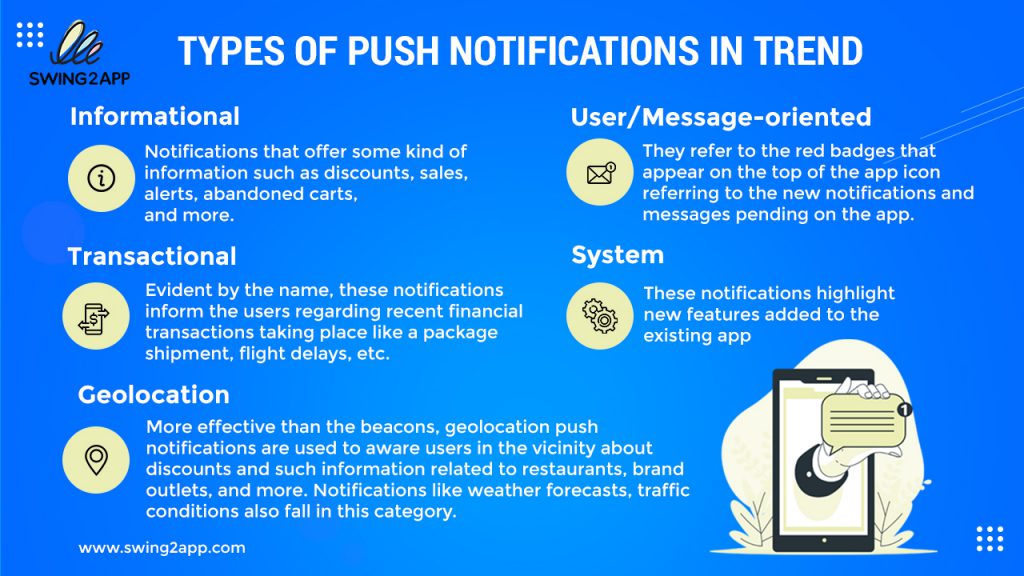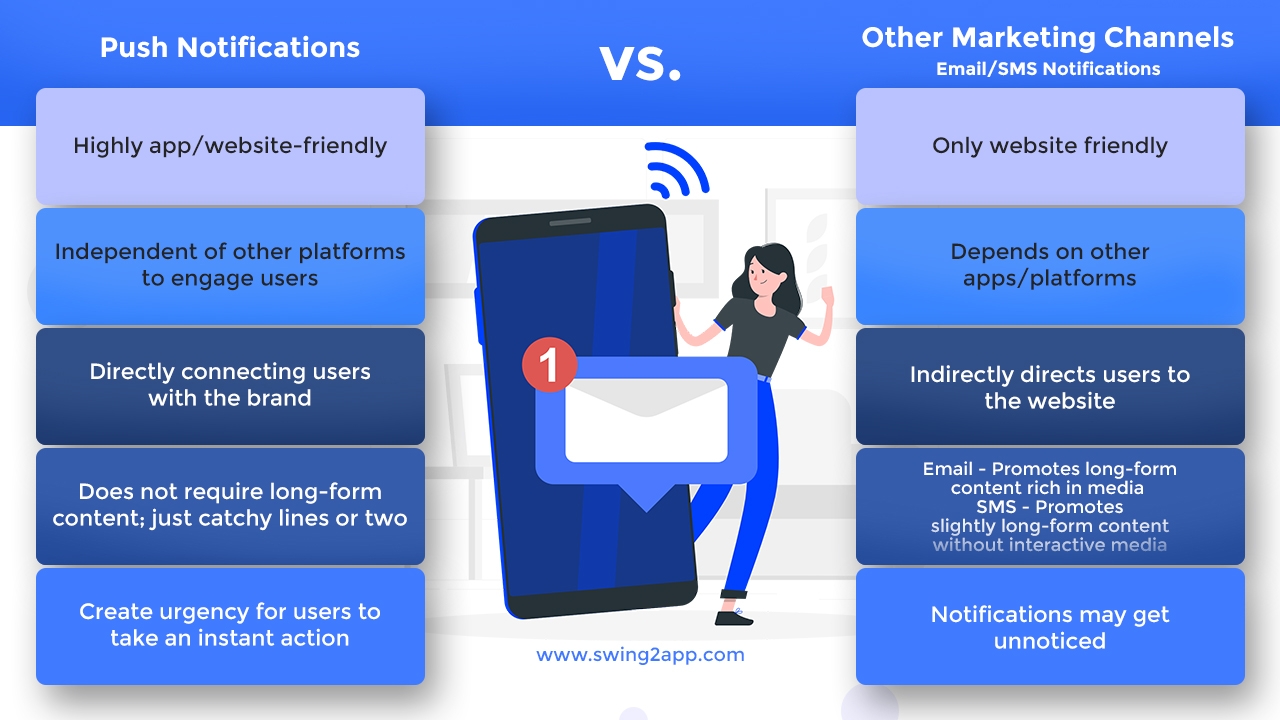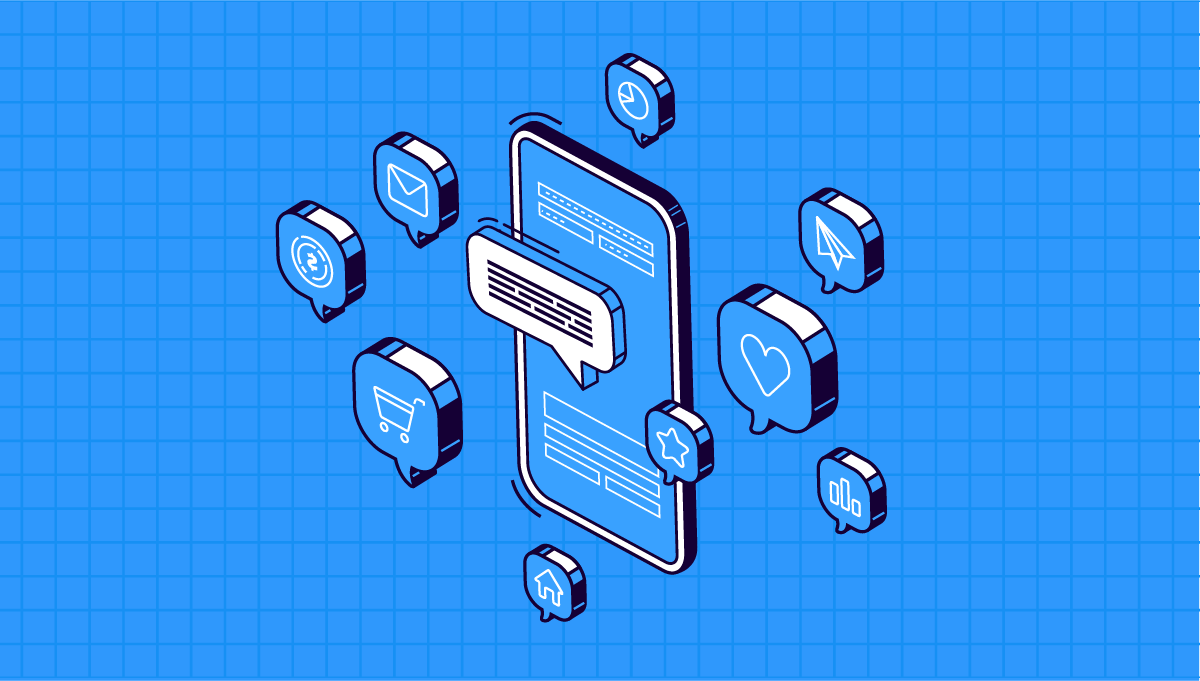Push notifications: a must have feature for apps
Customer engagement is witnessing a noticeable decline in its trajectory of popularity. One of the speculated reasons behind this is the changing attitude of customers and the inability of brands to capture it.
Once the underdog is now ruling the principles of customer engagement. In a report, it was mentioned that 87% of marketers report that they see visible improvement in engagement rates after applying personalization.
Now, if only you have been living under a rock you wouldn’t know about the effectiveness and benefits of push notifications in offering a personalized marketing experience to the users of your mobile app.
To say the least, companies can increase the retention rate by a staggering 190% by sending one or more push notifications within the first 90 days of app download.
To understand how you can use push notification for your mobile effectively, we need to know how many types of push notifications exist.

- Informational – Notifications that offer some kind of information such as discounts, sales, alerts, abandoned carts, and more.
- Transactional – Evident by the name, these notifications inform the users regarding recent financial transactions taking place like a package shipment, flight delays, etc.
- User/Message-oriented – They refer to the red badges that appear on the top of the app icon referring to the new notifications and messages pending on the app.
- System – These notifications highlight new features added to the existing app
- Geolocation – More effective than the beacons, geolocation push notifications are used to aware users in the vicinity about discounts and such information related to restaurants, brand outlets, and more. Notifications like weather forecasts, traffic conditions also fall in this category.
Push Notifications vs. Other Marketing Channels
To understand why using push notifications as a marketing strategy for your business is crucial, we need to compare it with the other conventional alternatives to show how insufficient they are.

1.Notifications via email marketing
Still, in use by many companies, Email marketing was once an irreplaceable part of outreach strategies and best practices for marketing to promote user engagement. Like everything, it had to come to an end due to the changing world and the people.
As people started to shift more towards smartphones than desktops, mobile apps than websites, email marketing was no longer the ultimate marketing tool it used to be. Thus, the engagement rate declined significantly.
Some of the reasons for this failure are too many emails in the inbox, thus increasing the chances of users checking your email and most of the emails end in the spam folder. Therefore, push notifications came to save the day for businesses as they can be used to promote content on mobile apps.
Unlike emails, push notifications show directly on the screen of the device, thus it is harder to get by unnoticed by the users. Also, by just clicking on it, users can be directed to the app or website directly.
However, one thing that we should probably not forget is that emails allow a brand to be more creative and elaborate than the push notification. Emails are ideal for long-form content containing images, vides, graphics, etc.
On the other hand, push notifications can only contain images, stickers, etc The content word-limit is also constrained so it has to be highly optimized to serve its purpose.
2.SMS notifications
SMS notifications were also used widely for marketing. It is still a strategy that businesses use, but the usage has a limit.
The barrier to creativity and the usage of rich-content has led to its decline in the world where many cost-effective and highly creative marketing tools are available. For instance, the push notification service provider OneSignal push notification service is deemed way better than SMS marketing.
SMS marketing is way more expensive than email marketing which only costs around $200-$1100 as compared to $500-$4000 for the former.
How push notifications are changing the customer engagement game in 2020?
We believe numbers speak better. To convenience you of the remarkable improvements and benefits push notifications offer, we need to discuss some push notification statistics before we get into the details.
- Using the A/B Testing, The Chicago Tribune saw a rise of 56% for its push notification open rate.
- If businesses improve the retention rate by only 1%, they see a 7% improvement in the revenue.
- On the days Gasbuddy sends notifications, they saw a staggering 24% increase in the daily active users count.
Now, that we are done with the numbers, let’s look for more evidence.
Easy opt-in and opt-out
Sometimes, a website might not be able to make a good first-impression in users’ minds. Thus, push notifications can allow them a second chance to do better. They will encourage them to engage with the website to see what the business offers.
Of course, in such cases, the users will not voluntarily or by themselves visit the website with which they share unpleasant experiences, but push notifications can push and motivate them to give another chance.
Unlike SMS messages, when users open a website, they are asked for permission if they want to be a part of the push notification campaign. Even in the case of mobile apps, users can go to the settings and stop the notifications from a particular app.
Interaction with the user is only a click away
Okay, let’s compare. When it comes to SMS marketing, users had to first open the message and then click on the link provided to land on the website. Similarly, with email marketing, a user is supposed to first open the email inbox, then the email, and then would reach the targeted website page.
But with push notifications, things are not unnecessarily complicated. Users are only required to click on the push notification in the notification bar and they will be redirected to the website or the app. This simple yet effective strategy enables businesses to push more users down the conversion funnel.
Retarget and retain
It is a known fact that acquiring new users for a business is even more expensive than retaining existing ones. If you want new customers, you would have to spend hundreds of dollars on advertisements to just get the attention.
Whereas, with an effective push notification strategy, you can make sure that your existing customer base is loyal and active. There are high chances of customers retaining on your website/app if they receive appropriate push notifications within the appropriate period.
With a viable notification, users will be more inclined to open them and re-visit your app/website to drive more business. Thus, a business has to make sure to devise personalized push notifications to ensure a high retention rate. Once this is taken care of, the engagement rate will improve in itself.
Creates urgency to increase CTR
Push notifications are a great way to create urgency among the users to interact with your website/app. For example, a notification informing of a limited-time offer or discount deal will make them more eager to click on the notification and land on your platform as soon as they read it.
You do not need long-form content but just a catchy heading with an interacting line or two with engaging emojis and other things to make it more interesting.
Easy user behaviour tracking
An effective analysis of user behaviour with your brand will allow you to offer services that users demand. This also helps in improving the existing services. To obtain this implicit feedback, a brand must know how to procure this useful information from a pile of numbers.
With push notifications, businesses can analyze the delivery receipts, open rates, open time, clicks on the notifications, etc to know how users are interacting with their brand. Businesses are more likely to easily evaluate which types of notifications users prefer
Last but not least, activate your inactive users
Your job does not end once the users download your app. Many times, users download the app but almost never even open it or if they do, the engagement is still lacking.
Therefore, a well-curated push notification strategy will take care of this issue. It will encourage them to interact and remind them of your services, unlike a website on which they once visited but never agreed to push notifications so there is no way to win them back.
Push Notifications: Do it right or don’t do it at all
After reading these amazing things about push notifications, we believe we have established a deep understanding and trust. Now, you must be thinking – ‘How to enable push notification for a mobile app?’.
{Know-How: Learn how to create your own app for free and without code}
Once you create an app you can avail of this service on the platform and boost the engagement on your app with the remarkable push notifications which would perfectly compliment your free app.
Isn’t this an amazing deal for businesses and especially startups with the dynamic and catalytic idea but limited capital?
